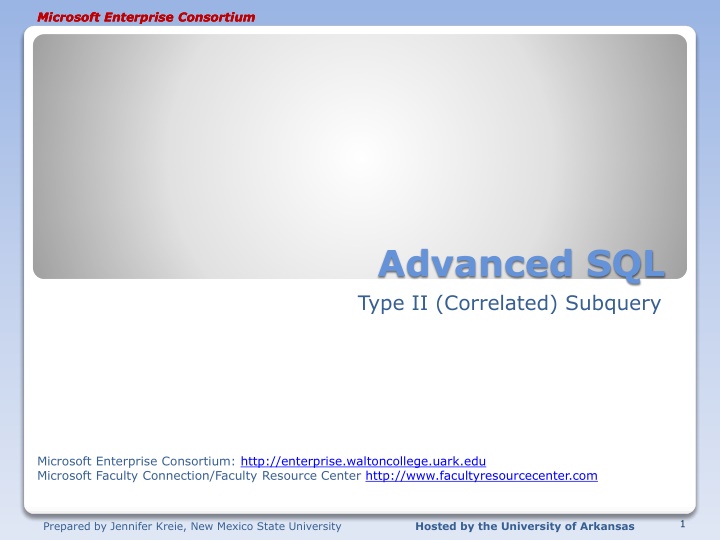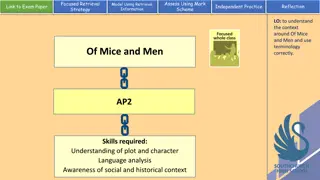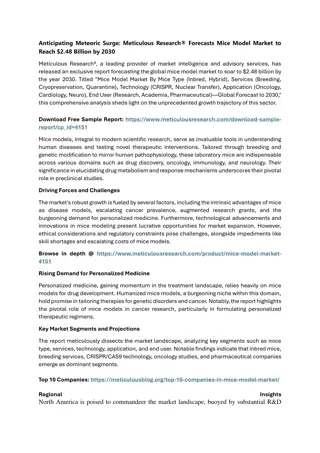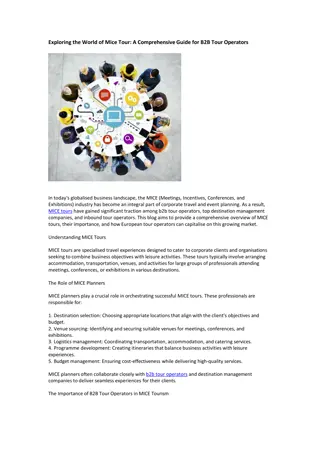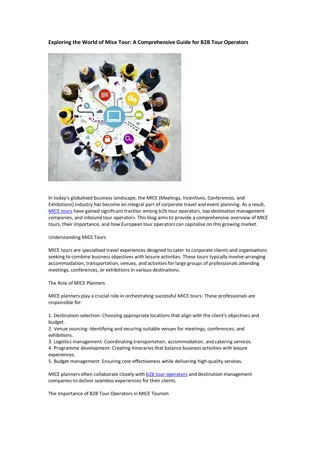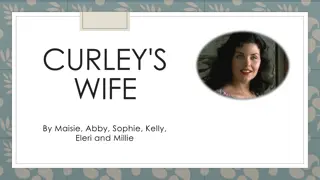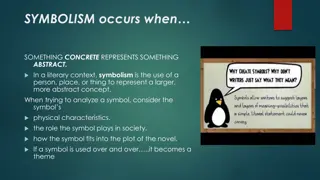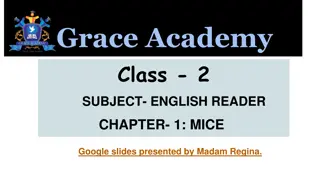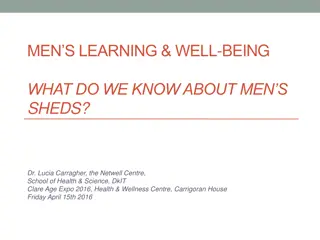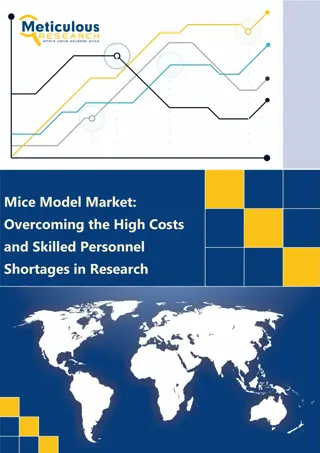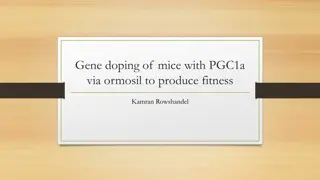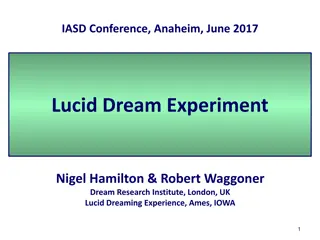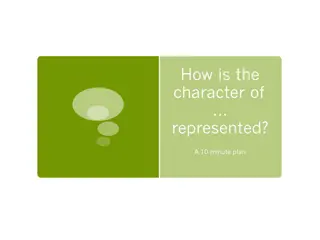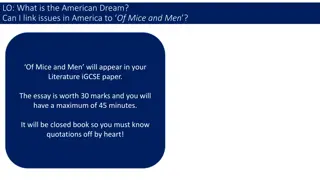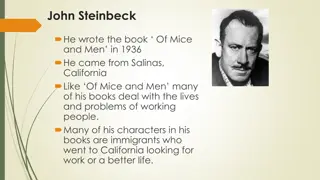The American Dream in 'Of Mice and Men'
Themes in John Steinbeck's novel "Of Mice and Men" revolve around the pursuit of the American Dream, focusing on characters striving for a better life and independence in a challenging world. The concept of the American Dream is explored through the characters' desires for stability, autonomy, and recognition, highlighting the obstacles they face in achieving their aspirations. The novel delves into the complexities of hope, companionship, and the quest for a place where individuals can fulfill their potential and live on their own terms.
Download Presentation

Please find below an Image/Link to download the presentation.
The content on the website is provided AS IS for your information and personal use only. It may not be sold, licensed, or shared on other websites without obtaining consent from the author.If you encounter any issues during the download, it is possible that the publisher has removed the file from their server.
You are allowed to download the files provided on this website for personal or commercial use, subject to the condition that they are used lawfully. All files are the property of their respective owners.
The content on the website is provided AS IS for your information and personal use only. It may not be sold, licensed, or shared on other websites without obtaining consent from the author.
E N D
Presentation Transcript
Microsoft Enterprise Consortium Microsoft Enterprise Consortium Microsoft Enterprise Consortium Advanced SQL Type II (Correlated) Subquery Microsoft Enterprise Consortium: http://enterprise.waltoncollege.uark.edu Microsoft Faculty Connection/Faculty Resource Center http://www.facultyresourcecenter.com 1 Prepared by Jennifer Kreie, New Mexico State University Hosted by the University of Arkansas
Microsoft Enterprise Consortium Microsoft Enterprise Consortium What you ll need Log in to MEC for this lesson and into MSSMS (Microsoft SQL Server Management Studio). Be sure to select your account ID under Database in the Object Explorer pane, similar to the example shown here. You should know the SQL covered in the SQL Fundamental series. You should know the Type I subquery covered in the previous tutorial. 2 Prepared by Jennifer Kreie, New Mexico State University Hosted by the University of Arkansas
Microsoft Enterprise Consortium Microsoft Enterprise Consortium Type II Subquery (Correlated) You saw that the Type I subquery executes independently from the outer query. The subquery executes then the outer query uses that temporary data set. This is the key difference between Type I and Type II. A Type II subquery references one or more columns in the outer query. The Type II subquery executes once for EACH row in the outer query. Type II subqueries are used for difference problems: What data in the outer query does NOT exist in the subquery? As with Type I, the Type II query output should NOT show any columns in the subquery. 3 Prepared by Jennifer Kreie, New Mexico State University Hosted by the University of Arkansas
Microsoft Enterprise Consortium Microsoft Enterprise Consortium Type II Subquery - Example /* S-T: List students working on the auto shop database project. Subquery: Find the team ID for the team working on the auto shop project. Outer query: List students assigned to that team ID. */ /* Type I subquery */ select stdid, stdfname, stdlname, std_teamID from students where std_teamID IN (select teamID from teams where project like '%auto shop% ); /* Type II Subquery */ select stdid, stdfname, stdlname, std_teamID from students where EXISTS (select * from teams where students.std_teamID = teams.teamID and project like '%auto shop%'); 4 Prepared by Jennifer Kreie, New Mexico State University Hosted by the University of Arkansas
Microsoft Enterprise Consortium Microsoft Enterprise Consortium Type II Subquery A closer look /* S-T: List students working on the auto shop database project. Subquery: Find the team ID for the team working on the auto shop project. Outer query: List students assigned to that team ID. */ select stdid, stdfname, stdlname, std_teamID from students where EXISTS (select * from teams where students.std_teamID = teams.teamID and project like '%auto shop%'); Join the outer query with the subquery in the subquery s WHERE clause. Unlike the Type I subquery, don t list a common field before the EXISTS keyword. You don t list the STUDENTS table in the subquery, although you reference that table in the WHERE clause. Also, it doesn t matter what field(s) you list in the SELECT clause of the subquery because it is not used by the outer query. 5 Prepared by Jennifer Kreie, New Mexico State University Hosted by the University of Arkansas
Microsoft Enterprise Consortium Microsoft Enterprise Consortium Type II Subquery Another Example /* Greenhouse: Show crops of type herb planted in sector B of the South Seed zone. Subquery: List bay-beds for zone South Seed, sector B. Outer query: List the crop_type, bay_bed, crop, and variety for the herb crop type. */ select crop_type, bay_bed, tblcrop.crop, variety from tblCropPlanting, tblCropVariety, tblCrop where tblCrop.crop = tblCropVariety.crop and tblCropVariety.cropVarID = tblCropPlanting.cropVarID and crop_type = 'Herb' and EXISTS (Select * From tblBay_Bed Where zone = 'South Seed' and sector = 'B' and tblCropPlanting.bay_bed = tblBay_Bed.bay_bed); 6 Prepared by Jennifer Kreie, New Mexico State University Hosted by the University of Arkansas
Microsoft Enterprise Consortium Microsoft Enterprise Consortium Type II Subquery Another Example /* Example of a DIFFERENCE problem. S-T: Show students who have not completed an evaluation. */ /* Incorrect attempt */ select stdid, stdfname, stdlname from students, evaluations where students.stdid <> evaluations.evaluatorID; /* Using the Type II subquery */ select stdid, stdfname, stdlname from students where NOT EXISTS (select * from evaluations where students.stdid = evaluatorID); 7 Prepared by Jennifer Kreie, New Mexico State University Hosted by the University of Arkansas
Microsoft Enterprise Consortium Microsoft Enterprise Consortium What was covered Type II (correlated) subquery. Example of Type I and Type II solutions. Solving a difference problem with a Type II subquery. 8 Prepared by Jennifer Kreie, New Mexico State University Hosted by the University of Arkansas
Microsoft Enterprise Consortium Microsoft Enterprise Consortium Resources http://enterprise.waltoncollege.uark.edu/mec.asp Microsoft Faculty Connection Faculty Resource Center http://www.facultyresourcecenter.com/ Microsoft Transact-SQL Reference http://msdn.microsoft.com/en-us/library/aa299742(v=SQL.80).aspx AdventureWorks Sample Database http://msdn.microsoft.com/en-us/library/ms124659%28v=sql.100%29.aspx 9 Prepared by Jennifer Kreie, New Mexico State University Hosted by the University of Arkansas
